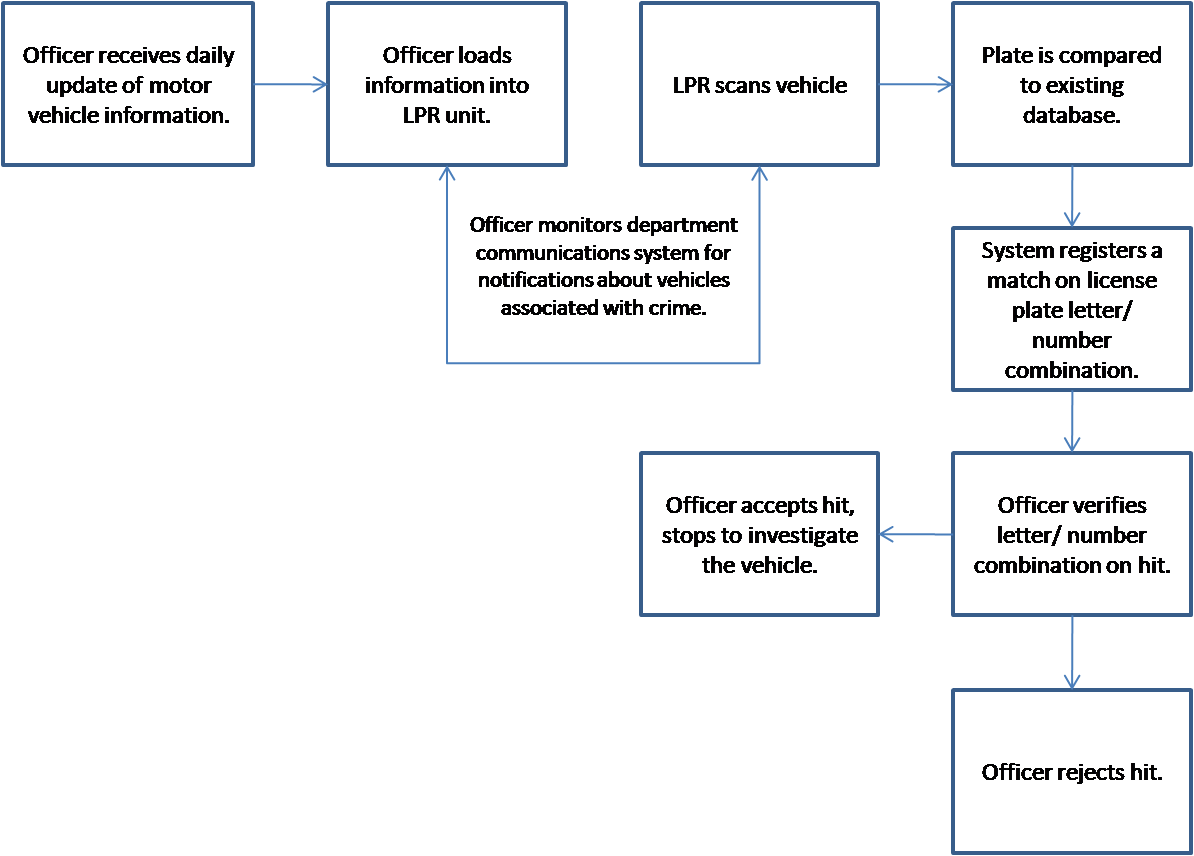LPR for the Community
LPR and Law Enforcement: A Summary for Citizens
License plate recognition technology was developed early in the 2000s and has since diffused quickly among police agencies in Europe and the United States. System configurations vary, but generally LPR is made up of one or more cameras and a mobile computer system. These systems are commonly mounted on marked police vehicles, but also may be placed on overpasses, turnpike gates, and wide variety of other locations. When an LPR system is turned on, the cameras ‘read’ license plates into the computer system, which interprets the captured characters and checks them against a database of vehicles known to be associated with a crime or suspected offender.

Above, we depict the normal course of operations, which involves the police receiving data on crime that is linked to motor vehicle information, loading that information into the LPR unit, and watching for updates from the department about vehicles that may have been involved in a crime. When the system registers a ‘hit’ the officer verifies that the vehicle matches the description of the vehicle involved in the crime and decides whether or not to further investigate. See Chapter 1 and Chapter 2 of our full report for more information on LPR use in the United States and abroad.
The George Mason University Community Survey
Our random sample survey provides interesting information on how one community views LPR use. Citizen opinions about this issue were complex and nuanced, and as our summary of the community perspective on police use of LPR indicates. Chapter 4 of our full report provides a complete summary of the methods used to obtain these data, as well as a copy of the survey instrument that used by the research team during this study. We highly recommend that police departments conduct similar surveys of their communities to understand the citizens’ perspective of LPR and refine their use of the technology.
For more articles related to this portion of the LPR project, see:
Linda Merola, Cynthia Lum, Breanne Cave and Julie Hibdon. (2014). Community Support for License Plate Recognition. Policing: An International Journal of Police Strategies and Management.
Linda Merola and Cynthia Lum. (2013). Predicting Public Support for the Use of License Plate Recognition Technology by Police. Police Practice and Research.
Linda Merola and Cynthia Lum (2012). Privacy and the impact of emerging surveillance technologies: The case of license plate recognition technology. Judicature 96(3): 119-126.
Considerations for Police Departments and the Community
As Jim Bueermann, President of the Police Foundation and former chief of the Redlands, California police department noted at the 2010 Stockholm Criminology Symposium, the goal of good policing is to “justify the investment that citizens have made in the police department”. Whether LPR is an example of ‘good policing’ that is worthy of the investment of citizens depends significantly on the particular data, tactics, and strategies used by police, as well as how the police inform and engage the community about the use of the system. Concerns about LPR deployment vary among different types of communities, and therefore a ‘one size fits’ all strategy of LPR deployment may not be appropriate in all settings. We instead recommend that departments and citizens consider the following questions about the use of this technology:
- What types of offenses does the community view as being a priority that should be targeted by police who use LPR?
- What types of data retention policies does the community support, and what types are perceived to be too invasive?
- What types of information should the police make publicly available about their use of LPR, and how can the public express concerns or support for the use of this technology?
- How can the police develop a set of transparent procedures concerning the types of crimes, places, and information that they will target using the LPR systems?
Resources:
What is legitimacy in policing?: A summary of the major concepts and issues by Lorraine Mazerolle
Policing for the People by Stephen Mastrofski
2016 LPR National Survey Report
The IACP Privacy Impact Assessment
2010 LPR Full Report by Lum et al.
Predicting public support of LPR by Merola and Lum (2013)
Community support for LPR by Merola et al. (2014)

